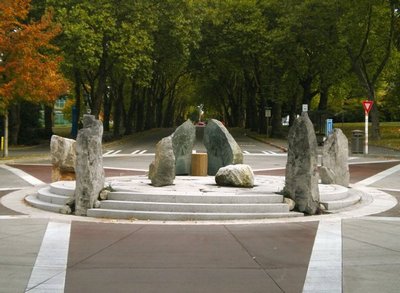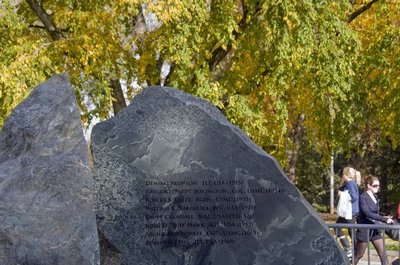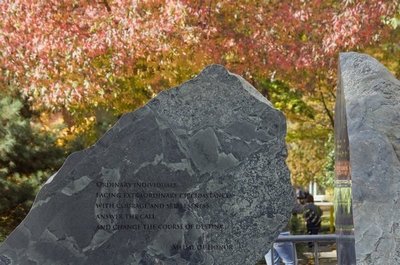October 21, 2009
New University of Washington memorial honors alumni who hold the Congressional Medal of Honor
They were eight ordinary men who did the extraordinary, who laid their lives on the line for those they loved both nearby and thousands of miles away, who rescued fellow soldiers at risk of their own lives, who took bullets so others didn’t have to, and who in one case defended the U.S. even though his family and friends were in internment camps.
The University of Washington will honor these Medal of Honor recipients who are also UW alumni with a new, prominent memorial to be dedicated Veterans Day, Nov. 11. <PTHE university except States. University nation?s highest award for military valor, and is usually presented by President United research indicates that UW has more Medal of Honor recipients among its alumni than any other public the service academies.
“The memorial will be a permanent, powerful reminder of the extraordinary things that can happen when ordinary people take action,” UW President Mark Emmert said.
Ceremonies will begin at 10 a.m. with a parade down Memorial Way that will include bands, veterans groups and a military color guard. General Peter W. Chiarelli, Army vice chief of staff and a UW graduate, will deliver the main address at 10:30 a.m. Members of the armed forces, both active and retired, as well as the general public are encouraged to attend.
The day’s events include “Ordinary Lives, Extraordinary Courage,” an Odegaard Undergraduate Library exhibit of letters, photographs, medals and other material related to the eight Medal of Honor recipients. Also, at least 15 Medal of Honor recipients from the Seattle region and elsewhere will be available to talk after the dedication, and ROTC units at the university will host an open house in the Clark Building.
Entirely funded by private contributions, the $152,000 monument is at the intersection of two existing war memorials. The first, Memorial Way, begins at the Northeast 45th Street entrance to the university and was created with 58 sycamore trees honoring UW faculty and students who died in World War I. At the end of Memorial Way, just south of the Medal of Honor memorial, is the campus flagpole bearing names of faculty, staff, students and alumni who died in World War II.
Michael Magrath, a UW visiting scholar in sculpture and public art, led the team that designed the monument. It includes Heidi Wastweet, a Seattle sculptor, and Dodi Fredericks, a landscape architect.
Their design is anchored by a five-point star, similar to the medal star, inset into the traffic circle. At the north point of the circle is the “book stone.” On the outside, it’s a plain serpentine rock that sat for years, largely ignored, outside the UW sculpture studio on lower campus. But “split open like a book and polished,” Wastweet said, “the stone glows like ordinary people courageous enough to do something extraordinary for their fellow human beings.”
The book stone includes each Medal of Honor recipient’s name, rank, award year and years at UW. A basalt column in front of the stone features the face of Minerva, goddess of both wisdom and war, who is pictured on the medal. “We want to inspire students who walk around and through the memorial,” Wastweet said. “We want them to think that if these alumni could do extraordinary feats, then they can, too.”
Near those rocks are four sentinel stones surrounding one with bronze wording from the recipients’ Medal citations. “We found that no image was as powerful as details of what those men did,” Wastweet said.
For more information about the memorial, visit http://depts.washington.edu/memorial.
Since 1862, when the Medal of Honor was first awarded, 3,448 U.S. service members have received it, 620 posthumously.
The UW memorial grew out of a Student Senate motion that set aside a proposed memorial to UW alumnus Gregory “Pappy” Boyington, class of 1934, a Marine fighter pilot who downed 28 enemy planes before the Japanese captured and sent him to a prisoner-of-war camp. The Senate favored a memorial recognizing all UW Medal of Honor recipients.
Funding for the memorial included a match program with TriWest Healthcare Alliance and the Bruce and Jolene McCaw Family Foundation.
“The monument honors those who fought not for medals but to save the lives of their comrades. Their courage and selflessness reflects the American spirit,” said David J. McIntyre Jr., president and chief executive officer of TriWest.
The eight UW alumni who have received the medal are:
Gregory “Pappy” Boyington, major, U.S. Marine Corps Reserve
As commanding officer of the Black Sheep Squadron in World War II, Boyington led his men in air battles that crippled Japanese forces. In October 1943, Boyington led 24 fighters over 60 Japanese planes parked on an airfield. During the battle that followed, American forces destroyed 20 enemy planes while losing none of their own. Though in his early 30s, Boyington was 10 years older than many of the men on his team; hence, the nickname “Pappy.”
Deming Bronson, first lieutenant, U.S. Army
Wounded by a hand grenade and a bullet, Bronson nevertheless led his unit in capturing enemy positions near Eclisfontaine, France, in 1918. At the UW, Bronson was a forestry major and played Husky football from 1912 to 1916.
Bruce Crandall, lieutenant colonel (ret.), U.S. Army
On Nov. 14, 1965, while under extreme fire in Vietnam, Crandall nevertheless made 22 trips to a battlefield in the Ia Drang Valley, resupplying troops with ammunition and collecting more than 70 seriously wounded soldiers. It inspired other helicopter pilots to join the effort. Like other medal recipients, Crandall earned not only the Medal of Honor but several other awards, such as the Purple Heart. The movie “We Were Soldiers” is based on the Ia Drang battle. Actor Greg Kinnear plays Bruce Crandall. For a review of the movie, go to http://community.seattletimes.nwsource.com/archive/?date=20020303&slug=crand
all03
Robert E. Galer, brigadier general (ret.), U.S. Marine Corps
As a major in 1942, Galer shot down 11 enemy aircraft in 29 days. He himself was shot down four times during World War II and the Korean War. Galer retired as a brigadier general in 1957.
John D. “Bud” Hawk, sergeant, U.S. Army
On Aug. 20, 1944 in Normandy, Hawk was largely responsible for crushing two German attempts to escape Allied troops and for taking more than 500 prisoners, all while he was wounded from a bullet to the thigh.
Robert Leisy, second lieutenant, U.S. Army
On Dec. 2, 1969, North Vietnamese soldiers attacked Leisy’s unit, outnumbering them 10 to 1. Leisy used his own body to shield his fellow soldiers from a rocket-propelled grenade. Then, while mortally wounded, he continued to direct his men, refusing medical treatment until others were cared for. Leisy was 24 at the time of his death. He had been in Vietnam less than three months.
William Kenzo Nakamura, private first class, U.S. Army
Twice on July 4, 1944, Nakamura singlehandedly attacked German machine gunners in Italy so his platoon could be freed from pinned-down positions. During his second effort, he was killed. Nakamura had volunteered for the Army after the U.S. government forced his family and other Japanese-Americans on the West coast to move to internment camps.
Archie Van Winkle, colonel (ret.), U.S. Marine Corps
In November 1950, Van Winkle led a charge through Chinese gunfire. One bullet shattered his arm, and a hand grenade exploded against his chest. Refusing to be evacuated, Van Winkle continued shouting orders and encouragement to his men. The platoon eventually repulsed a fanatical enemy attack.
###
For more information, contact Catherine O’Donnell at 206-543-2580 or cath2@uw.edu; Michael Magrath at 206-276-6038 or mmagrath@gmail.com .



